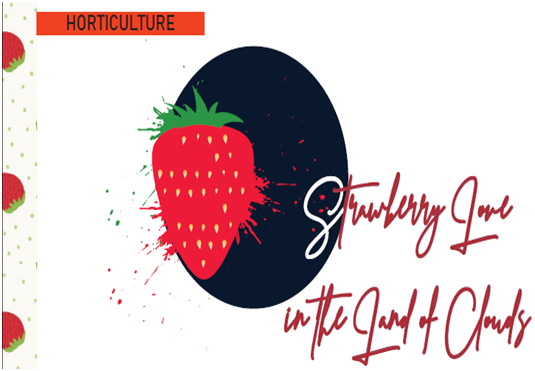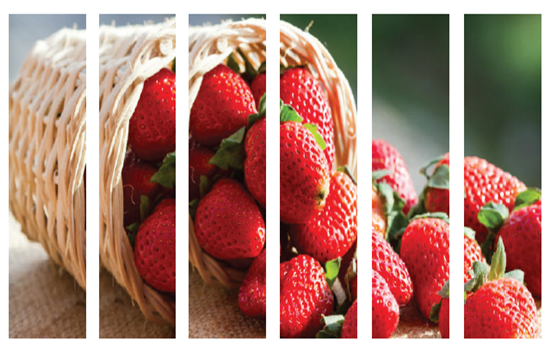
Meghalaya also known as “The Abode of Clouds”, is one of the most beautiful states hidden in the hills of eastern sub-Himalayas. It is a land blessed with bountiful rainfall, sunshine with flourished biodiversity. Meghalaya has a variation of agroclimatic zones, ranging from temperate to tropical, which offer tremendous scope for cultivation of temperate as well as tropical fruits and vegetables.
Amongst all, strawberry is the prominent and successful introduction which has changed the economic landscape of the strawberry growers in Meghalaya. This small red fleshed berry is one of the showcase crops of Meghalaya which has dramatically transformed and impacted a sizable number of rural households with farmers earning more per season from this lusciously red, heart-shaped fruit as compared to other crops. Strawberry as one of the low volume high-value berry has also been largely responsible for the emergence of Meghalaya as one of the top horticulture states of the country.
Meghalaya is well suited for the cultivation of strawberries with an array of agroclimatic conditions from tropical to temperate elevation from 150-2000msl temperature (2degree to 36 degree Celsius) and abundant rainfall (1200 cm annual average). The soil is rich in organic matter, deep, well drained in many parts of the state and with a pH range of 5.5 to 6.5, ideal conditions for strawberry varieties like Camarosa, Sweet Charlie etc. In fact, a wild strawberry known locally as Sohsan grows abundantly in the hills of the East and West Khasi Hills with sweet but small size and difficulty with an appreciable quantity of the fruit which could be harvested, has precluded any attempts to commercialize the crop. Strawberry prefers soil reasonably rich in humus because 70-90% of its roots spread in the top 15cm with a pH value of 7.5 but the plant thrives best in the slightly acidic soil. Among all the different types of berries, strawberry gives the quickest return in a shortest possible period.
agroclimatic conditions from tropical to temperate elevation from 150-2000msl temperature (2degree to 36 degree Celsius) and abundant rainfall (1200 cm annual average). The soil is rich in organic matter, deep, well drained in many parts of the state and with a pH range of 5.5 to 6.5, ideal conditions for strawberry varieties like Camarosa, Sweet Charlie etc. In fact, a wild strawberry known locally as Sohsan grows abundantly in the hills of the East and West Khasi Hills with sweet but small size and difficulty with an appreciable quantity of the fruit which could be harvested, has precluded any attempts to commercialize the crop. Strawberry prefers soil reasonably rich in humus because 70-90% of its roots spread in the top 15cm with a pH value of 7.5 but the plant thrives best in the slightly acidic soil. Among all the different types of berries, strawberry gives the quickest return in a shortest possible period.
The geo-climatic situation of Meghalaya offers an excellent scope for the growth of different types of horticultural crops besides, it is perennial in nature and offer larger bio-mass production. Horticulture crops and their products have the highest potentiality for export and foreign exchange earnings and enable productive and economic utilization of cultivable wasteland. It also provides a viable alternative to shifting cultivation as well as checks soil erosion and improves ecological balance.
Meghalaya’s strawberry story would not be complete without mentioning the place from where it all started. Located barely 35 kilometers from the State Capital of Shillong in Ri Bhoi District of Meghalaya, at the end of a dusty rural track, the sleepy idyllic hamlet of Sohliya seems an unlikely birthplace of a revolution- a horticulture revolution. The villagers are simple folks, agricultural laborers most of them, toiling away in their own little patches of land or as laborers in rich people’s tea gardens, till, they came across a deep red, heart-shaped, luscious fruit- the strawberry.Strawberry Love in the Land of Clouds.
The strawberry cultivation in Meghalaya started way back in 1998, when an enterprising and visionary farmer Mr. Ostander Lyngkhoi or Bah Os, Headman, and resident of Sohliya village in Umsning Block of Ri- Bhoi, planted 50 Israeli Strawberry plants which he got from his friend, Mr.L.Wansmet who in turn got runners from his son working in Pune. He realized the potential of the fruit as a revenue-generating crop for his village. After he got in touch with Mr.E.Shanpru, the then District Horticulture Officer of Ri-Bhoi being the proactive and farmer-friendly officer, he immediately initiated a small trial of 497.9 square meters in the Dewlieh Horticulture farm of the department in Umsning in 2003-04 to test the veracity of Bah Os’ claims. The trial was successful with a production of 1500 kgs of strawberries which were probably the very first time that Meghalaya had seen in real life. However, under the initiative of Technology Mission for the Integrated Development of Horticulture in the North Eastern Region and Government of Meghalaya, Centre of Excellence which was conceived since 2004-2005 was implemented in Dewlieh in collaboration with Horticulture department. This was the start of the low volume highvalue horticulture revolution in Meghalaya. In 2007 and under the guidance of the Center of Excellence, the farmers organized themselves into the Ri-Bhoi Strawberry Growers Association (RBSGA) and with their active participation, Sohliya village located in Ribhoi district was selected as a hub of strawberry cultivation in Meghalaya, endowed with climatic conditions conducive to their growth. The Centre of Excellence equipped with modern post-harvest facilities was created as a one-stop aggregation, marketing center and a technology clearing hub for all things, to cater to the needs of strawberry growers of the state and serve as a catalytic demonstration of improved methods of cultivation, management, marketing and processing of the crop such that the farmers need not look anywhere else for assistance and which is still today the only centre dedicated to strawberries in the state.
On 14th February 2005, strawberries made a big splash on Valentine’s Day when the office of the District Horticulture Officer, Ri-Bhoi District, launched Meghalaya’s and the country’s first strawberry Festival with the tagline “Say it with Strawberries”. The Festival was a huge success and catapulted both strawberries and Meghalaya, as a horticultural state with huge potential into the limelight both at the state and the National Level. Today the cultivation of the crop has expanded to all eleven districts of the state with 99 hectares crop area in 2016-17 and a total production of 831 metric tonnes. The crop has been the cause of economic upliftment of entire villages, especially Sohliya Village and has been the reason in many of the other districts for the economic empowerment of farmers, especially women and the emergence of successful farmer entrepreneurs.
To read the further article please get your copy of Eastern Panorama March issue @http://www.magzter.com/IN/Hill-Publications/Eastern-Panorama/News/ or mail to contact @easternpanorama.in


